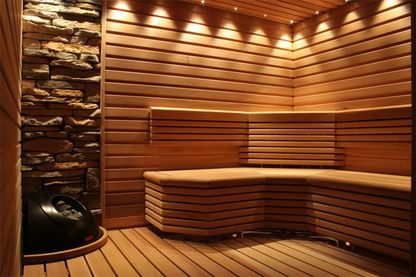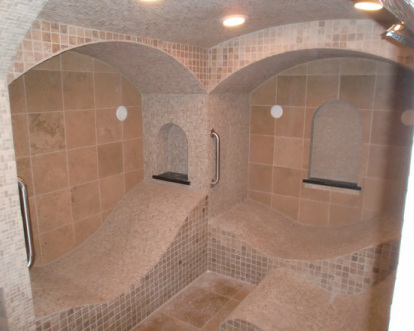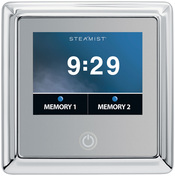Sauna & Steam Bath Certified Repair Service
Technician
|
A daily sauna or steam bath is a remarkable way to
indulge yourself. It causes perspiration which is the
single healthiest thing you can do for your skin by unblocking
pores and removing toxins. Other benefits include clearing of
the sinuses, lowering blood pressure and muscle relaxation.
For the mind and soul stress and negativity are quickly
dissipated in the intense yet comforting heat. A few
minutes of daily is an opportunity to
improve your overall well-being in every way. It is
important to take a shower after either a sauna or a steam
bath to wash away impurities that have poured from the body.
Maximum sweat rates of an adult can be up to 2-4 liters per
hour.
|
Sauna
is an ancient Finnish word referring to the
traditional Finnish bath and to the bathhouse
itself which is a small room or house designed
as a place to experience dry or wet heat
sessions, or an establishment with one or more
of these and auxiliary facilities. A sauna
session can be a social affair in which the
participants disrobe and sit or recline in
temperatures typically between 158 degrees F.
and 212 degrees F. Manual control of the
temperature is achieved with multiple seat
levels. Saunas can be divided into two basic
styles: conventional saunas that warm the air or
infra red saunas that warm objects. Infrared
saunas may use various materials in their
heating area such as charcoal, active carbon
fibers, and other materials.
|
|
Steam Bath
is an ancient type of bath, first made popular
by the ancient Greeks and Romans. These Roman
baths were supplied by natural hot springs from
beneath the ground.
There are many different types of steam baths,
which are different than a
sauna
. (Both are hot, but the steam in a sauna is
created by throwing water on a stove.)
|
Steam Bath/Room Upgrades
|
|
Touch Control
With finger-light touchscreen
operation, this sets a new
standard for user-friendly steam
bath operation. Installs inside
steam shower. High-contrast
display of adjustable settings for
Total Sense functions. Two user
profiles can be programmed, so
each user can customize steam
shower to his or her preferences.
Uses touchscreen technology to set
and change settings for
temperature, duration and spa
options that enhance the steam
bathing experience with aroma,
color and music.
|
The control is equipped with
advanced technology to link with
the new mySteamist™
application for your iPhone®
or Android mobile device. Once you
download mySteamist from
iTunes® or Google Play,
you’ll be able to activate
pre-programmed user profiles
within your home network range.
Steamist gives you mobile
flexibility at no additional cost!
|
Sauna & Steam Bath Services Available
Renovation, Repair and Replacement of:
- Tile and other surfaces
- Sauna Heaters
- Steam Generators
- Digital Solid State Control Systems
- Chroma Therapy Lighting
- Audio and Video Systems
- Customer Support
- Tile and other surfaces
- Sauna Heaters
- Steam Generators
- Digital Solid State Control Systems
- Chroma Therapy Lighting
- Audio and Video Systems
- Customer Support
Steam Generator Maintenance
The water tank should be drained and
flushed at least every six months
to reduce scale build up. The most efficient way of doing this is to add the optional
automatic drain system to the generator so the tank is drained and flushed
after every steam bath.
A steam room is an ideal place for bacteria to breeding ground as it's small, has low light and is constantly wet and high in humidity. Regular maintenance of a steam room requires washing it out thoroughly with a hose and spraying it down with ceramic tile cleaner or an antibacterial cleanser like bleach. Do not use bleach straight, mix with water in a empty spray bottle at a ratio of 25% bleach to 75% water. Pay attention to the grout and tiles in the steam room, looking for cracks or chips where mold or bacteria can get a foothold. If you find cracks, seal them with a silicon sealant or grout.
Leaving the steam room door open for several hours so it can fully dry out after each use will help promote a bacteria free environment.
to reduce scale build up. The most efficient way of doing this is to add the optional
automatic drain system to the generator so the tank is drained and flushed
after every steam bath.
A steam room is an ideal place for bacteria to breeding ground as it's small, has low light and is constantly wet and high in humidity. Regular maintenance of a steam room requires washing it out thoroughly with a hose and spraying it down with ceramic tile cleaner or an antibacterial cleanser like bleach. Do not use bleach straight, mix with water in a empty spray bottle at a ratio of 25% bleach to 75% water. Pay attention to the grout and tiles in the steam room, looking for cracks or chips where mold or bacteria can get a foothold. If you find cracks, seal them with a silicon sealant or grout.
Leaving the steam room door open for several hours so it can fully dry out after each use will help promote a bacteria free environment.













